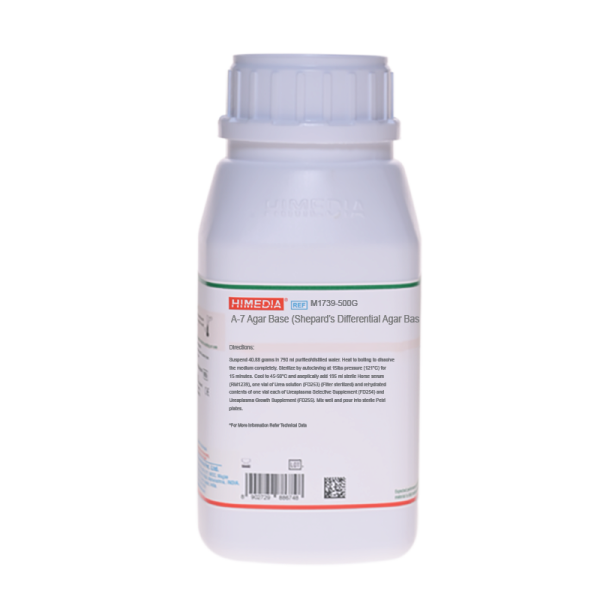 Your enquiry has been submitted
Your enquiry has been submitted
A7 Agar Base (Shepard’s Differential Agar Base)
Intended Use
Recommended for the cultivation and differentiation of Ureaplasma urealyticum from urine, based on its ability to produce ammonia from urea. Also used for the cultivation of other Ureaplasma species.
Composition**
| Ingredients | g / L |
|---|---|
| Tryptone | 12.830 |
| Agar | 15.000 |
| Sodium chloride | 3.800 |
| Soya peptone | 2.280 |
| Dipotassium hydrogen phosphate | 1.900 |
| Dextrose (Glucose) | 1.900 |
| Manganese sulphate | 0.730 |
| Yeast extract | 2.440 |
Final pH ( at 25°C): 6.0±0.2
**Formula adjusted, standardized to suit performance parameters
Directions
Suspend 40.88 grams in 790 ml purified / distilled water. Heat to boiling to dissolve the medium completely. Sterilize by autoclaving at 15 lbs pressure (121°C) for 15 minutes. Cool to 45-50°C and aseptically add 195 ml sterile Horse serum (RM1239), 1 vial of U Solution (FD253) (Filter sterilized) and rehydrated contents of 1 vial each of PG Selective Supplement (FD254) and GroVitAm Enrichment Supplement (FD255). Mix well and dispense as desired.
Principle And Interpretation
This medium is used for selective cultivation of urogenital Mycoplasma, viz. Ureaplasma urealyticum from clinical samples based on its ability to produce ammonia from urea (1). The medium contains tryptone and soya peptone which provide nitrogen and carbon compounds, long chain amino acids, vitamins and other necessary nutrients for the growth of Ureaplasma. Yeast extract provides preformed nucleic acid precursors, necessary for the growth of fastidious Ureaplasma. Glucose is the carbohydrate source. Sodium chloride maintains the osmotic balance.
Many Mycoplasma/Ureaplasma require serum for their good growth and also the presence of antibiotics is necessary to prevent the growth of contaminating organisms. Ureaplasma possess the enzyme urease and hence breakdown the urea to ammonia. Bacteria that produce ammonia appear as golden to dark brown coloured colonies (1).
Type of specimen
Clinical samples - Urine
Specimen Collection and Handling
For clinical samples follow appropriate techniques for handling specimens as per established guidelines (2,3).
After use, contaminated materials must be sterilized by autoclaving before discarding.
Warning and Precautions
In Vitro diagnostic Use only. For professional use only. Read the label before opening the container. Wear protective gloves/protective clothing/eye protection/ face protection. Follow good microbiological lab practices while handling specimens and culture. Standard precautions as per established guidelines should be followed while handling clinical specimens. Safety guidelines may be referred in individual safety data sheets.
Limitations
- Although this medium is selective for gram negative organisms, biochemical identification and serological testing using pure cultures is recommended for complete identification.
- It is advised to incubate for recommended period and temperature to avoid misinterpretation of results.
Performance and Evaluation
Performance of the medium is expected when used as per the direction on the label within the expiry period when stored at recommended temperature.
Quality Control
Appearance: Cream to yellow homogeneous free flowing powder
Gelling: Firm, comparable with 1.5% Agar gel
Colour and Clarity of Prepared medium: Light yellow coloured clear to slight opalescent solution forms in Petri plates.
Reaction: Reaction of 4.08% w/v aqueous solution at 25°C. pH : 6.0±0.2
pH: 5.80-6.20
Cultural Response: Cultural characteristics observed after an incubation at 35-37°C for 18-48 hours, with added RM1239, FD253, FD254, FD255.
| Organism | Inoculum (CFU) | Growth | Urea |
|---|---|---|---|
| ^Ureaplasma parvum ATCC 14027 | 50-100 | Good-luxuriant | positive reaction |
Key- ^ Formerly known as Ureaplasma urealyticum
Storage and Shelf Life
Store between 10-30°C in a tightly closed container and the prepared medium at 2-8°C. Use before expiry date on the label. On opening, product should be properly stored dry, after tightly capping the bottle in order to prevent lump formation due to the hygroscopic nature of the product. Improper storage of the product may lead to lump formation. Store in dry ventilated area protected from extremes of temperature and sources of ignition Seal the container tightly after use. Product performance is best if used within stated expiry period.
Disposal
User must ensure safe disposal by autoclaving and/or incineration of used or unusable preparations of this product. Follow established laboratory procedures in disposing of infectious materials and material that comes into contact with clinical sample must be decontaminated and disposed of in accordance with current laboratory techniques (2,3).
Reference
- Atlas R. M. 2004, Handbook of Microbiological Media, 3rd Ed, CRC Press, Boca Raton, Florida.
- Isenberg, H.D. Clinical Microbiology Procedures Handbook. 2nd Edition.
- Jorgensen, J.H., Pfaller , M.A., Carroll, K.C., Funke, G., Landry, M.L., Richter, S.S and Warnock., D.W.(2015) Manual of Clinical Microbiology, 11th Edition. Vol. 1.
| Product Name | A7 Agar Base (Shepard’s Differential Agar Base) |
|---|---|
| SKU | M1739 |
| Product Type | Regular |
| Physical Form | Powder |
| Origin | Animal |
| Packaging type | HDPE |
| References | 1.Atlas R. M. 2004, Handbook of Microbiological Media, 3rd Ed, CRC Press, Boca Raton, Florida. |
| Customized Product Available | No |








